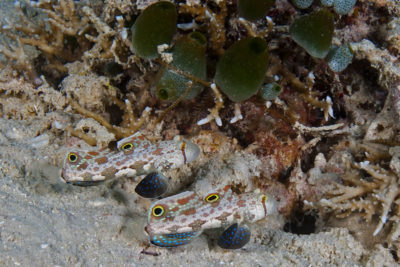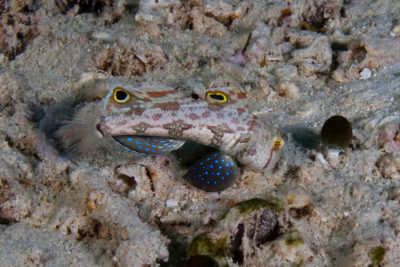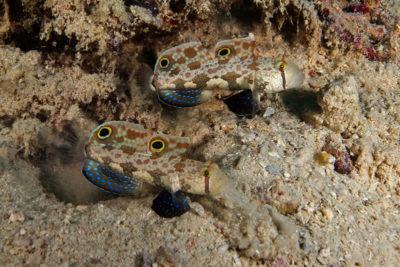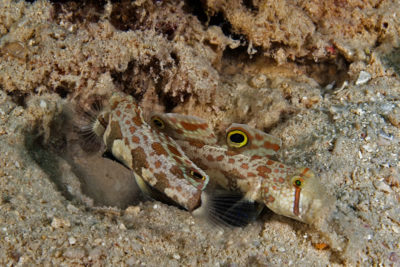Expedition Log: Palau – Day 20
While doing coral reef surveys in Palau we select sites to get a variety of different habitats while trying to cover as many reef systems as possible.
Many of the dives we do are within the large lagoonal areas along the west side of Palau. These dives are in sheltered areas, protected from swift currents and high seas. The relatively still water can allow corals to build very delicate colonies with fragile branches, requiring extra care to survey around. These sites are also characterized by large amounts of sand and sediment that often covers the reef, making it look like a snowscape. Ecosystems dominated by areas of sand and soft sediment are home to a variety of creatures well adapted to this environment. Sea cucumbers graze on the sediments processing organic detritus for their sustenance. Nudibranchs feed upon hydroids, giving them the unpalatable taste that is advertized by their bold warning coloration. Tube-dwelling anemones bury their base within the sand where they will hide if disturbed. There is also a diverse assemblage of fish species that are at home in heavily sedimented areas.
One of my favorite “muck dive” species is a small goby known as the Twinspot Signal Goby (Signigobius biocellatus).
On a small lagoonal patch reef a little south of the West Passage, we were in the perfect environment to see them. Just after finishing one of my coral photo transects on a strip of reef packed with feathery colonies of stinging hydroids, I spotted a pair. They didn’t seem spooked by my presence, so I settled down in the sand and began to watch their behavior.

Mated pair of Twinspot Signal Gobies near their burrow which is barely visible among the coral rubble and green Urn Tunicates.
Over the next few minutes I started to see a pattern in their behavior. They paused for a moment near their burrow under a cluster of green Urn Tunicates (Atriolum robustum) whenever a larger fish swam by overhead. They would occasionally swim forward and backward in an erratic manner. This characteristic behavior (along with the two ocellated spots on their dorsal fins) is what has caused some to call them Crab-eyed Gobies for this possible mimicry. The vertical line running down their face and through their “true” eyes aids in this deception—a marking shared by many butterflyfishes which also sport large ocellated “eye” spots on their bodies. I watched them make a circuit with several stops along the way, always returning to their burrow for a moment or two before setting out on the next lap. Whenever they stopped they would bend down and suck up a mouthful of sediment. This sandy sediment was then sifted through their gill rakers searching for small benthic invertebrates that live within the sediment which are their primary food source. As they swim they generally fold their fins down for reduced drag but when they stop they raise their twinspotted dorsal fins and extend their anal and pelvic fins which are dark with brilliant electric blue spots adding to their charm.

As the gobies move through their small range, they stop frequently to suck in a mouthful of sediment, sifting through it for tiny invertebrates.
In no time I had worked out their pattern and was able to sit with the camera resting on the bottom not too far from their burrow. There I would wait for them to complete their series of stops before returning to pause in front of my lens letting me snap off a few shots. This technique that I had learned years ago worked well until one circuit when I noticed the pair deviate. Instead of returning to the burrow where I was stationed, they instead ventured “off track” and to my surprise ducked down into a second burrow I hadn’t noticed before. Quickly, I repositioned near this new location and in a few moments was rewarded by seeing one of the pair emerge from the burrow with a mouthful of sediment. This time the little goby was not feeding but instead was in the process of excavating a new burrow. For several minutes I had the pleasure of watching this pair alternately take turns diving into the burrow to return a moment later with a bulging mouth of sediment that was spat out not to far from the entrance. While one was busy vacuuming up a mouthful the other stood guard near the entrance. As soon as each load was ejected, that fish would take up watch and the other would turn tail and zip into the burrow for its turn in excavating the ever-enlarging second home. Fascinated and entranced, I appreciated my good luck at being able to watch this pair busily at work constructing their burrow. I enjoyed this tiny natural history show until I needed to get back to work. Silently, I thanked the couple for allowing me this short glimpse into their world and I headed off to do my next photo transect.


I watched this pair building a new burrow, repeatedly disappearing into the hole to return with a mouthful of sediment which was quickly spat out near the entrance. As one partner unloads a mouthful of sediment, the other one, which was acting as a lookout for any danger, turns and dives into the burrow to take its turn at the excavation.
(Click-thru on images for greater detail.)
Photos by Ken Marks.